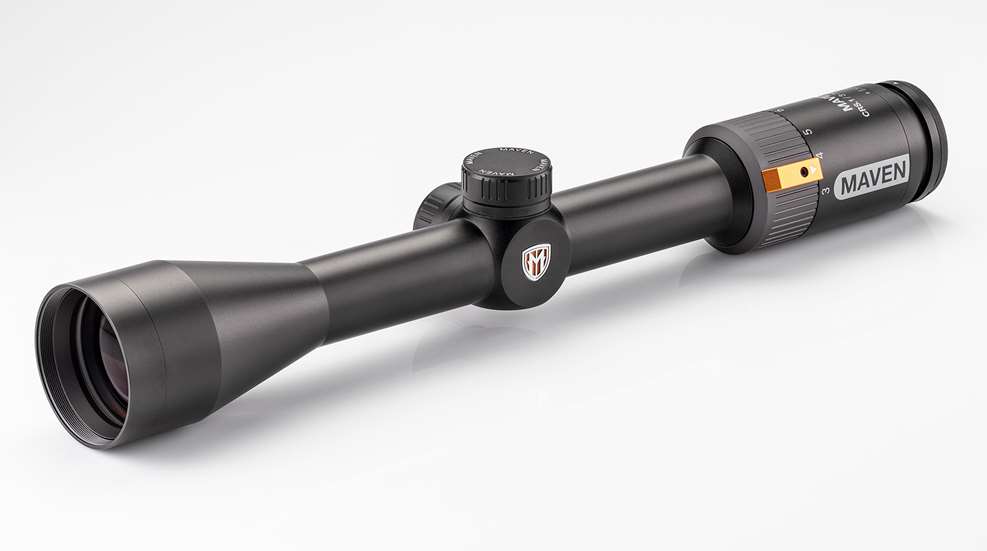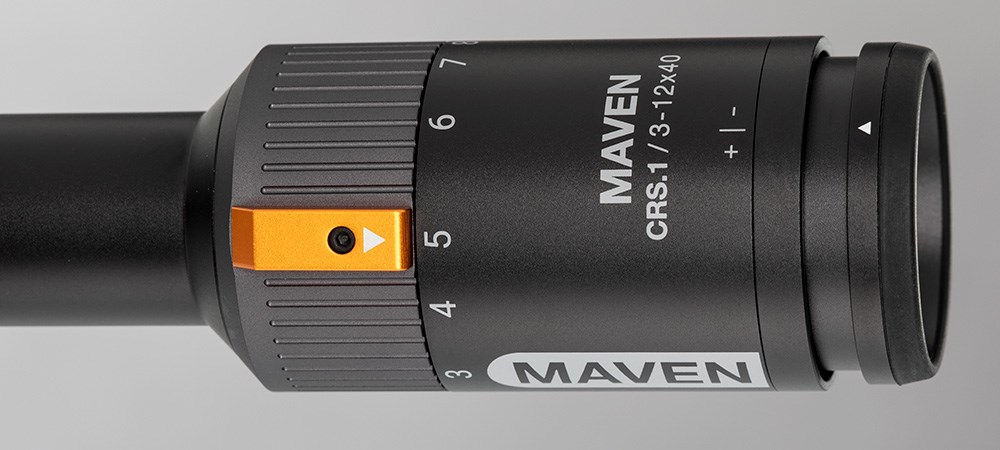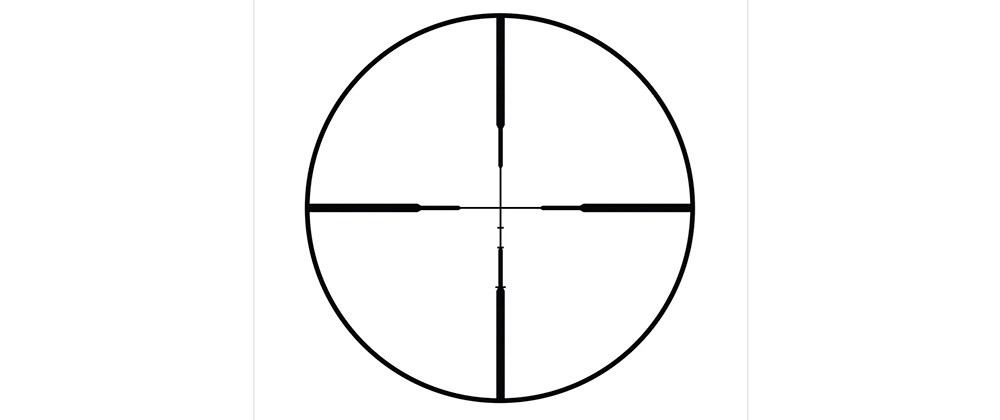
The roadmap to success in life has been drawn by wise men and philosophers for centuries: simplify, simplify, simplify. The up-to-date version is KISS: keep it simple, stupid.
Maven Outdoor Equipment Company of Lander, Wyo., does just that with its CRS.1 3-12x40mm riflescope. At 14.2 ounces with just four adjustment knobs, this scope promises to do just what hunters need—put bullets on target.

With this Maven scope there is no need to turn on a light. No batteries to die. No need to dial an elevation turret. No need to dial a windage turret. No cussing when you shoot over your game because you forgot to return the elevation dial to zero. No need to pull out an anemometer, consult a smartphone app or call a friend. Just know your rifle, know your trajectory, and hunt. Hike, glass, spot, stalk, close within sure range and make your shot. You are hunting.
Crazy idea. Yet that’s how deer, elk, pronghorn and sheep hunters have been succeeding for several hundred years. And even today, 22 years into the 21st century, we can still immerse ourselves in fieldcraft instead of technology.
That’s not to say there isn’t plenty of technology in this scope. You don’t build a riflescope this bright, this sharp, that zooms from 3X to 12X, keeps its reticle centered throughout that zoom range, dials out 132 clicks and back to return to zero without some precision manufacturing. You don’t get a bright, sharp image, high contrast and excellent flare control without applying the latest technology to build your lenses. But by minimizing the bells and whistles, you don’t get overweight and overwhelmed, either.
Having been “on the scene” during the release and perfection of the first 3X-9X zoom scopes, I’ve had a lifetime to watch scope evolution and test most of its promises. And while I appreciate the advanced capabilities of today’s most elaborate scopes, I more enthusiastically appreciate true hunting scopes that keep it simple. This Maven does. But that doesn’t mean there isn’t a fly or two in the soup.
As an optics aficionado, I like to know what ingredients make up the “scope du jour.” Alas, Maven withholds this information. I found no information in the packaging or on the Maven website explaining anything about this instrument’s anti-reflection coatings. Sure, the proof is in the pudding—what you see is what you get—but knowing if the lenses are single-layer coated, fully multi-coated or something in between helps me assess their quality within their price range.

As most scope users know, anti-reflection coatings play a big role in light transmission and flare control. Total transmission can be difficult to see, but you can detect flare quite easily by searching distant shadows for details while aiming the scope so that the rising or setting sun shines directly onto the objective lens. If the scene is compromised by haze or orange flare and glare, the lenses are poorly coated and reflecting too much light. Those reflections then bounce lens to lens within the instrument, adding flare and glare and compromising contrast as well as resolution. To my delight, this Maven did not, suggesting it does have adequate, even more than adequate, anti-reflection coatings. My call to the company confirmed this. Why Maven, like so many optics brands these days, doesn’t advertise this in its literature baffles me.
A pragmatist might suggest one need only test the scope to ascertain such things, and this is true, but not every scope buyer can effectively test drive a scope in a retail shop. In fact, you can’t test drive this unit or any other Maven in any retail store because all Maven optics are sold direct to save middleman mark-ups. But Maven may offer something even better: a test drive guarantee. According to their website, “All stock Maven products can be returned within two weeks for full credit minus initial shipping cost. Items must be in new condition.” You buy the scope, try it and send it back if you don’t like it. You pay the shipping costs.
I tested a sample CRS.1 3-12x40 and, were I planning to buy, I would not ship it back. Here’s why: Cosmetically it is sleek and clean with smooth lines with one concession for the eyepiece/power knob. It appears somewhat abrupt and oversized. But pretty is as pretty does, and this gray, knurled ring with a raised, orange aluminum index bar is easy to grasp. It turns smoothly with just the right amount of tension and no backlash. This precise, smooth function is repeated in the adjustable diopter ring at the end of the eyepiece. The small, short turret caps turn on and off smoothly and tighten nicely against rubberized bases that both secure them and prevent water incursion, not that it should matter because the unit is guaranteed waterproof to a submersion depth of 3 meters. I did not test this with my usual “kitchen sink” experiment, but recommend buyers do so. Simply return the scope if bubbles emerge and water enters.
 The second focal plane CRS.1 sports Maven’s updated Simplified Holdover Reticle (CSHR), with MOA subtensions.
The second focal plane CRS.1 sports Maven’s updated Simplified Holdover Reticle (CSHR), with MOA subtensions.
As for turret accuracy, both elevation and windage turrets are crisply marked in white, ¼ MOA per click. In practice they click rather easily but precisely with a fairly crisp snap. Whether I ran them up, down, left or right, both regularly and reliably returned to their zero markings, even if I dialed to the wall. The ¼ MOA accuracy, however, was slightly off, not surprising in a scope at this price level. A 3 MOA adjustment fell short by one click, or ¼ MOA. Six MOA fell short by 2 clicks, or ½ MOA. With many rifles/bullets in the .270 Winchester class, six MOA would be close to the correction called for at 500 yards where ½ MOA equals 2.5 inches. Not a huge problem on the side on an elk, but problematic on a coyote, unacceptable on targets. But then again, this is a hunting scope and is not designed to be dialed for long-range corrections. The windage dial showed a similar inaccuracy, but I find that easy to ignore for the same reason—it’s not designed to dial corrections in the field. Zero this scope and use maximum point-blank range (MPBR) or reticle holdover for accurate placement. Even if you do dial corrections, you’ll be “game good” to at least 400 yards, easily within the ranges at which most of us take game.
This brings us to the second focal plane reticle, a triple step-down wire crosshair with 5, 10 and 20 MOA sub reticles on the lower vertical line. The step downs guide the eye to center in low light. The 5 MOA hash might prove perfect for a 400- to 550-yard shot depending on your cartridge, bullet and drop. It would be just about the right aiming point for a 26 Nosler shipping a 142-grain AccuBond Long Range at 3340 fps, or a .30-06 shooting a .525 BC bullet 3000 fps and zeroed 2.8 inches high at 100 yards. In general, however, 5 MOA hash marks offer limited versatility. On the bright side, they don’t throw a confusion of lines and numbers to mess up the sight picture. Were I running this scope on one of my hunting rifles, I’d zero it for MPBR on a 6-inch target, then go to my traditional “high holds” until nearing the 5 MOA aiming mark.
This scope’s reticle position didn’t change with power, either. Whether I dialed down from 12X to 3X or vice versa, the reticle center stuck stubbornly to the original aiming point. Parallax was nicely controlled at 100 yards, too. All in all, this relatively inexpensive scope passes with flying colors.
The CRS.1 3-12x40 ships with a neoprene field cover plus a set of steel, Picatinny rail clamp Warne rings that matched and fit perfectly when you spend another $20 on the bundle package. Couple all of this with Maven’s base price of $450 and I can’t help but give it a thumbs up.
Technical Specifications
• Type: variable-power riflescope
• Magnification: 3X-12X
• Objective Lens Diameter: 40mm
• Eye Relief: 3.7"
• Exit Pupil: 13.2mm (3X), 3.4mm (12X)
• Field of View @ 100 Yards: 34 ft. (3X), 8.5 ft. (12X)
• Reticle: CSHR (Simple Holdover Reticle)
• Adjustments: ¼ MOA per click, 50 MOA max adjustment range
• Coatings: fully multi-coated
• Dimensions: 1" tube; length 12.44"; weight 14 ozs.
• Construction: matte black, 6061-T6 aircraft aluminum tube; waterproof; nitrogen purged
• Accessories: neoprene cover
• MSRP: $450; mavenbuilt.com


































